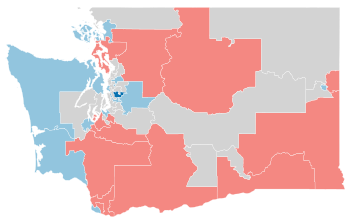| |||||||||||||||||||||||||||||||
26 seats of the Washington State Senate 25 seats needed for a majority | |||||||||||||||||||||||||||||||
|---|---|---|---|---|---|---|---|---|---|---|---|---|---|---|---|---|---|---|---|---|---|---|---|---|---|---|---|---|---|---|---|
| |||||||||||||||||||||||||||||||
 Results: Democratic gain Republican hold Democratic hold No election | |||||||||||||||||||||||||||||||
| |||||||||||||||||||||||||||||||
| Elections in Washington |
|---|
 |
The 2016 Washington State Senate elections is one of the biennial legislative elections in Washington in which about half of the state's 49 legislative districts choose a state senator for a four-year term to the Washington State Senate. The other half of state senators are chosen in the next biennial election, so that about half of the senators, along with all the members of the Washington State House of Representatives, are elected every two years. 25 seats are regularly scheduled to be up this cycle, along with 1 additional seat holding a special election to fill an unexpired term: the 36th district, currently held by appointed Senator Reuven Carlyle, whose former incumbent Jeanne Kohl-Welles vacated the seat.
A top two primary election on August 9, 2016 determines which candidates appear on the November ballot. Candidates were allowed to declare a party preference.[1] The general election took place on November 8, 2016.[2]
The 2016 Election maintained effective Republican control of the Senate, because self-identified Democrat Tim Sheldon caucuses with the Republicans.
Cite error: There are <ref group=lower-alpha> tags or {{efn}} templates on this page, but the references will not show without a {{reflist|group=lower-alpha}} template or {{notelist}} template (see the help page).

